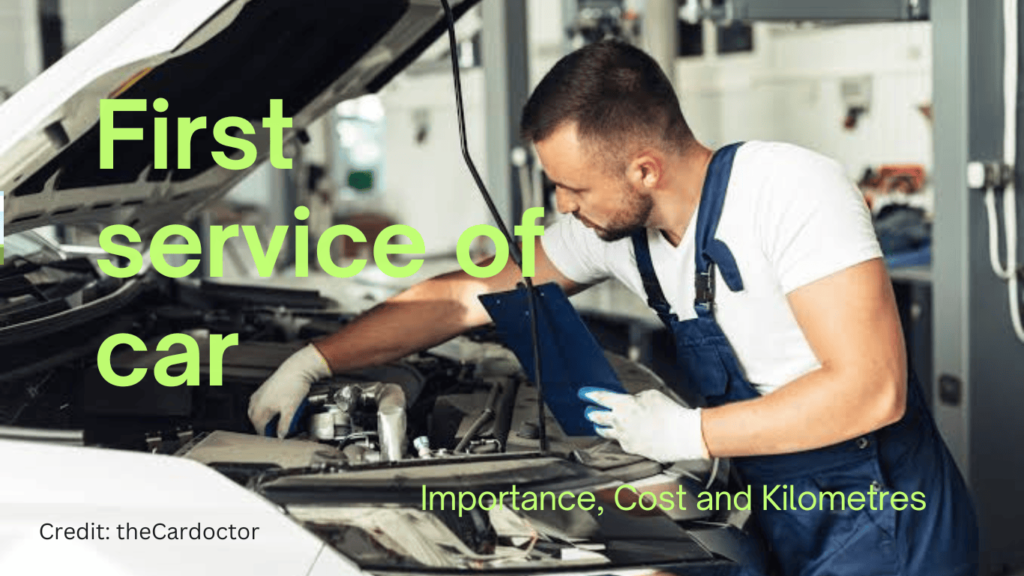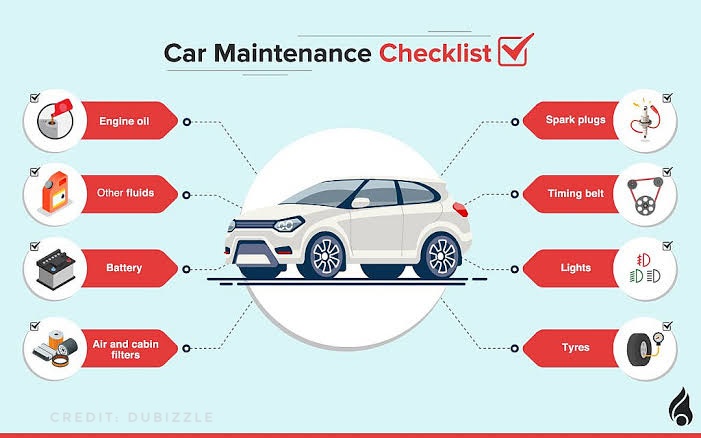
The new car owner wonders: Why is the 1000km First Car Service Important and What Do They Check? Is a long drive safe before the first service? We address all your queries about the first car service, including the cost, the necessity of an oil change, What happens when you delay car servicing., and the maximum speed permissible before the first service. Stay with us to find all the answers without any doubt.
I work as a former assistent manager in one of Maruti Suzuki dealership, and I have insider knowledge about the service stations. Here, I will do my best to guide you on vehicle servicing. I’ll also provide advice on your car’s future paid service and share some tips for basic car care at home, helping you save a significant amount on vehicle maintenance.
Why first car service is Important
When you buy a new car, all its parts are brand new, and many components are in relative motion with each other. The first 1000 to 2000 kilometers are crucial for a new car because, before the parts fully settle into their working state, putting a high load on them is not advisable.
Parts like those in the gearbox, engine, and wheel bearings release small debris during this relative motion. If this debris gets stuck between working parts, it can lead to potential failures. In the first car service, technicians check these points, along with the engine oil, brake oil, and other fluid levels, for leaks. By addressing any issues in the first service, we can prevent more significant problems and safeguard the car’s future performance. This is why the first service of a car is considered highly important.
READ MORE: How to Wash Car at Home with Easy steps, Benefits and Precautions
What is the first service kilometer for your car?
The first service interval for Indian cars depends on the company, but it’s generally around 1 to 2 months or 1,000 to 2,500 kilometers, whichever comes first. During the first service, they usually check all electrical systems, coolant and other fluid levels, filters, and ensure all systems are working properly.
Here is a more specific breakdown of first service time periods for different car companies:
| Car Companies | First Service Time Period |
|---|---|
| Maruti Suzuki | 1-2 months or 1,000 kilometers |
| Hyundai | 1-2 months or 1,500 to 2,000 kilometers |
| Tata | 1-2 months or 1,500 to 2,000 kilometers |
| Kia | 1-2 months or 1,200 to 1,500 kilometers |
| Toyota | 1-2 months or 1,500 to 2,000 kilometers |
| Honda | 1-2 months or 1,500 to 2,000 kilometers |
| Renault | 1-2 months or 2,000 to 2,500 kilometers |
| Nissan | 1-2 months or 2,000 to 2,500 kilometers |
| Volkswagen | 1-2 months or 2,000 to 2,500 kilometers |
| Škoda | 1-2 months or 2,000 to 2,500 kilometers |
Points To Be Checked In The First Service Of Your Car
The new car owner often wonders, What is done in the 1st car service?” and “What is included in the first free service?” In this explanation, I will provide detailed information about the points checked during the new car’s first service, helping you understand the key aspects of this initial service.
Before becoming an assistant manager, I worked as a technician for almost 1.5 years in 2015 and 2019. During this time, I personally serviced many vehicles for their ‘first services.’ Here, I will share my perspective on the points I checked and why they are important.
Service stations usually claim to check around 70 to 80 points during the first car service. Here, I’ll simplify these points based on different car systems, such as the electrical system, fuel system, infotainment systems, auxiliary system, etc.

Different System and Points to be Checked
Electrical System:
- Battery: First, they check the battery bracket and holder. If these are loose, it can lead to damage to the battery body, terminals, and wires. After that, they inspect the electrolyte (battery water) level and top it up with distilled water if necessary.
- All Lights: After checking the battery, they proceed to inspect all the lights. One person operates the lights while another checks their performance, including the main bulb of the headlight, both upper and dipper beams, signal lights, hazard lights, tail lights, brake lights and intterior roof lights.
- Wiring Harness and Sockets: This practice is also important. They check the main engine wiring harness conditions, ensuring they are properly fitted at their positions. They inspect all connectors and sockets by hand, ensuring that everything is properly connected and mounted in its place. They also check for any cuts or damage to wires.
Engine oil, Coolant and fluid check:
- Engine Coolant: After inspecting the electrical system, they move on to check the engine coolant. First, they cool down the car engine and check the coolant level in the coolant reservoir tank. If the level is low, they top up some coolant and then proceed to check for leaks from all coolant pipes. Generally, in the first service, it’s rare to find any leaks in a car.
- Engine Oil: Engine oil is the lifeblood of a car engine, so there is no compromise when checking it. The engine oil is checked with the dipstick mounted on the upper or side portion of the engine. First, the technician opens the dipstick, removes oil using cotton, dips it into the engine oil, removes it, and then checks the level of engine oil on the dipstick. On the dipstick, there is a marked level, and if the level is proper, there is no need to top up the oil. If needed, they add some oil.
- Brake Oil: Brake oil is also important, just like engine oil. Generally, in BS VI vehicles, we use DOT 4 oil in the brake system. First, the technician checks the level, and if needed, they add some DOT 4 brake oil.
- Windshild washer fluid: Windshield washer fluid is used for cleaning the windshield glass and rear door glass. Similar to brake oil, the technician checks the level and adds a mixture of shampoo and water if needed.
Fuel System: In the fuel system, we typically inspect for leaks in the pipes, lines, and injector mountings, including the high-pressure common rails. The technician begins by lifting up the car to examine the underside. First, they inspect the fuel tank for any damage or leaks. After that, they check all the fuel lines for damage and leaks. Once the car is lowered, they inspect the fuel lines in the engine compartment. It is rare to find any leaks during the first car service.
Infotainment Systems: In modern Indian cars, there are numerous infotainment features. As a technician, I first check the cluster meter operation during a test drive. In this process, I examine the fuel gauge, speedometer, and odometer operations. After that, I set the time and date in the system and test the FM radio and music system, checking all the speakers and the steering buttons’ operations for volume control and other functions.
Wheels and Tyre: First, check the tire pressure and the wear on the tires. If uneven wear is found, then check the alignment. However, generally, in the first car service, this happens very rarely.
Door lubrication & Body Noice check: While conducting the first car service, we check for any body noise during the test drive. If we notice any, we use lubrication or cushioning material to adjust the angles of the body and reduce or eliminate the noise.
After checking for body noise, we move on to lubricating the doors using grease or any other lubrication spray. If necessary, we adjust the doors. Similarly, we also lubricate the hood (bonnet) hinges.
I have covered almost all the points here, and I hope that this information helps you understand your first car service and what points need to be checked during the first service of your car.
READ MORE: What is Graphene Coating? Good for the Car?
Is First service free?
In India, almost all auto manufacturers offer three free services for a car. However, there is a catch – they only cover the labor charges. If you opt for additional services like underbody coating, paint protection, or need any parts replaced, you will be charged for those. So, if you only get the basic service done, your first service is free. But if you choose additional services, you’ll have to pay for them.
For example, in the Maruti Suzuki Alto model, they replace the engine oil during the first service, and in such cases, the car owner needs to pay for the engine oil. So, Alto owners will have to pay for the engine oil in the first car service.
frequently asked questions
First Service of New Car After How Many Km?
Typically in India, the first service of a car is performed between 1000 km to 1500 km, depending on the car manufacturer. For companies like Maruti Suzuki, Hyundai, and TATA, the first service is done at 1000 km to 1500 km or within 1 to 2 months, whichever comes first. On the other hand, companies like Toyota, Skoda, Renault, and Nissan schedule the first service between 1500 km to 2500 km or 2 to 5 months, depending on whichever comes first.
If you need a detailed answer to your question, read the above article, where I cover in full detail the first service kilometers and time periods.
What is the max speed we can drive a new car until the first service and what are all the things needed to be considered?
There is no specific rule for maximum speed during the first drive, but it’s better to drive slowly, around 50 to 80 km/h. Since all the parts of a new car are also new, it’s advisable not to put too much load on them.
Many parts, such as gearbox parts, engine parts, and wheel bearings, are in relative motion, and they generate small debris. If this debris gets stuck between these moving parts, it may lead to damage. Therefore, I suggest driving slowly during the first drive to prevent potential damage to these parts.
Can I do the First Service Before 1000 km?
Yes, you can perform the first service before reaching 1000 km, but I recommend driving your vehicle for at least 700 to 800 km for a better assessment of new parts such as the gearbox, engine moving parts, and wheel bearings.
The first car service is determined by two factors: running kilometers and time periods. If you haven’t reached 1000 km but it’s been one month since your purchase, it’s advisable to proceed with the the first car service.
How soon should I service a new car?
The service schedule for a new car depends on the company, but generally, the first service is conducted between 1000 km to 2500 km or 1 month to 2 months, whichever comes first.
For companies like Maruti Suzuki, Hyundai, and Tata, the first service for new vehicles is performed at 1000 km or 1 month, whichever comes first. For companies like Toyota, Škoda, Volkswagen, and Nissan, the first service for new vehicles is conducted at 2000 km or 2 to 3 months, whichever comes first.
Does 1st service increase mileage?
No, the first service does not increase mileage. New cars typically offer their maximum mileage, and the first service is usually done between 1000km to 1500km. During this period, your car already provides its maximum mileage. While the first service doesn’t increase mileage, it plays a crucial role in helping your car maintain its high mileage performance.
Conclusion
The first service of a car is as important as any other service because there is a risk of potential damage. You only need to wait for one month or 1000 km, as in India, the time period and distance for the first service are relatively short. Once the first service is done, you can drive stress-free, and afterward, you can enjoy high-speed driving too.
I hope this information helps you understand the importance of the first car service. Now you know how many kilometers you need to cover for the first service, along with the benefits and costs associated with it. If you want to know more about your car, you can visit our other articles on car maintenance and related topics.



[…] EXPLORE: Why is 1000km First Car Service Important and Checking points? […]
[…] Read More: Why is 1000km First Car Service Important and Checking points? […]
[…] EXPLORE NEW: Why is 1000km First Car Service Important and Checking points? […]
[…] EXPLORE: Why is 1000km First Car Service Important and Checking points? […]
[…] EXPLORE: Why is 1000km First Car Service Important and Checking points? […]